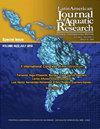New insights on expression and purification of a recombinant luciferase protein from the bioluminescence marine dinoflagellate Pyrocystis lunula
IF 0.8
4区 农林科学
Q3 FISHERIES
Latin American Journal of Aquatic Research
Pub Date : 2023-08-31
DOI:10.3856/vol51-issue4-fulltext-2898
引用次数: 0
Abstract
Bioluminescence is interesting, among other reasons, for the various technological applications that have been derived from it. Among these applications, developing visualization techniques to record the expression of one or more genes simultaneously in real-time are particularly useful. With this in mind, this study aimed to generate a recombinant Pyrocystis lunula luciferase protein (Luci D2-3 partial CDS). As the main results, i) a fragment of 1467 bp of the luciferase (LCFb) mRNA of the dinoflagellate P. lunula, containing part of domain 2 and all of the domain 3, was cloned in the pET28a vector; ii) the constructed vector was used to transform Escherichia coli to express the recombinant protein and subsequently purify it through an affinity chromatography procedure using a His-Tag; and iii) the purified protein (~50 kDa) was further analyzed by mass spectrometry to confirm its identity. Despite being unable to perform activity tests with the luciferin substrate, the evidence from previous studies indicates that the recombinant protein obtained in this case is enzymatically active. Due to the limited number of currently available luciferases, synthesizing this recombinant protein represents a useful tool, especially in designing expression assays coupled to multiple reporter genes, thus expanding the palette of proteins available for developing this type of biotechnological advances.重组荧光素酶蛋白的表达和纯化研究
生物发光之所以有趣,除了其他原因外,还有它所衍生的各种技术应用。在这些应用中,开发实时记录一个或多个基因表达的可视化技术尤其有用。考虑到这一点,本研究旨在产生重组肺焦孢子虫萤光素酶蛋白(Luci D2-3部分CDS)。作为主要结果,i)在pET28a载体中克隆了一个1467bp的甲藻轮状芽孢杆菌的荧光素酶(LCFb)mRNA片段,该片段包含结构域2的一部分和结构域3的全部;ii)将构建的载体用于转化大肠杆菌以表达重组蛋白,并随后通过使用His-Tag的亲和层析程序将其纯化;以及iii)通过质谱法进一步分析纯化的蛋白质(~50kDa)以确认其身份。尽管不能用荧光素底物进行活性测试,但先前研究的证据表明,在这种情况下获得的重组蛋白具有酶活性。由于目前可用的萤光素酶数量有限,合成这种重组蛋白是一种有用的工具,特别是在设计与多个报告基因偶联的表达测定中,从而扩大了可用于开发这类生物技术进步的蛋白质的范围。
本文章由计算机程序翻译,如有差异,请以英文原文为准。
求助全文
约1分钟内获得全文
求助全文
来源期刊

Latin American Journal of Aquatic Research
FISHERIES-MARINE & FRESHWATER BIOLOGY
CiteScore
1.70
自引率
10.00%
发文量
44
审稿时长
4-8 weeks
期刊介绍:
Latin American Journal of Aquatic Research- LAJAR is the continuation of the journal Investigaciones Marinas (1970-2007) and is published since 2008 by the Escuela de Ciencias del Mar, Facultad de Ciencias del Mar y Geografía of the Pontificia Universidad Católica de Valparaíso. LAJAR is an “Open Access” journal that publishes in English language, original research articles, reviews and short communications on aquatic science, which contain the results of research conducted in aquaculture or in oceanic and coastal marine waters of Latin America.
The following topics are considered: Physical Oceanography, Chemical Oceanography, Marine Biogeochemistry, Marine Pollution and Toxicology, Marine Geology and Geophysics, Biological Oceanography, Fisheries and Aquaculture.
 求助内容:
求助内容: 应助结果提醒方式:
应助结果提醒方式:


